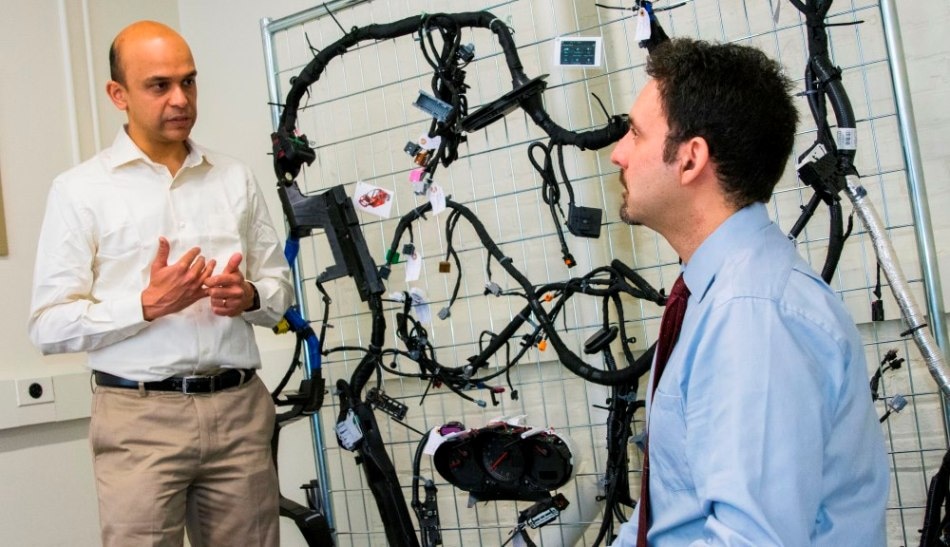Feb 19 2018
Two researchers – an electrical and computer science engineer and an aerospace engineer at Worcester Polytechnic Institute (WPI) – are integrating their work to find new ways for making self-driving cars that can function efficiently and safely, even in congested city environments.
 Raghvendra Cowlagi, left, and Alexander Wyglinski, in the MITRE-WPI Collaboratory. Behind them is the wiring harness for a 2014 Chevrolet Impala, which is used for student projects on autonomous vehicle security. (Image credit: Worcester Polytechnic Institute)
Raghvendra Cowlagi, left, and Alexander Wyglinski, in the MITRE-WPI Collaboratory. Behind them is the wiring harness for a 2014 Chevrolet Impala, which is used for student projects on autonomous vehicle security. (Image credit: Worcester Polytechnic Institute)
Both researchers received a three-year, $425,000 award from the National Science Foundation (NSF), which is being used to bring together different fields of work—wireless communications and decision making for self-driving cars—to form a network that will allow these vehicles to share data about everything from road conditions to traffic flow and accidents.
By allowing vehicles to communicate and base their actions and decisions on the data they receive, the scientists hope that they can make it viable for autonomous cars to cruise more safely on highways at a speed of 70 mph and navigate through crowded city streets – a feat that still continues to be a challenge for current autonomous vehicles.
Raghvendra Cowlagi, the principal investigator for the project and assistant professor of aerospace engineering, concentrates on self-driving vehicles, or cars, that use computer intelligence to operate independent of a human driver. Alexander Wyglinski, co-PI on the project and associate professor of electrical and computer engineering, is an expert in the wireless communications required to give self-driving cars the awareness of their environments that will allow them to operate in a more safe and efficient manner. Despite being complementary, the two areas of research are not usually integrated, which according to the WPI team can be very challenging.
“There is a huge disconnect between the self-driving car community and the connected vehicle community,” said Wyglinski, who is also president of the IEEE Vehicular Technology Society. “We’re trying to change that. The more information a self-driving car can take in from cars around it will help its decision-making algorithms make the correct decision. If we can unify the research, we’ll have self-driving cars making decisions they couldn’t make using radar, lidar, and sensors alone.”
Part of Cowlagi and Wyglinski’s work is to find out how to combine the information from the car’s onboard sensors with the data being wirelessly transmitted from other adjacent self-driving vehicles about their speed, and what kind of accidents and traffic congestion they are perceiving with their own onboard sensors.
Even standard vehicles requiring human drivers can transmit, although limited, data, like the those emitted from cell phones or tire sensors in the car, which will inform an autonomous vehicle that the other car is close by.
“This is time-critical information, so we need a network that can handle that,” Wyglinski said. “The wireless link can’t have any delay, and there can be no dropped data packets, which cause network interference. If you’re on a highway going 70 mph and there is a car accident just ahead, you need that information without a hitch.”
In addition, the researchers are studying how the network can discard unrelated data from possibly hundreds of connected vehicles in the area, so the vehicle can concentrate on the data it needs to make instant decision-making. For instance, if the car intends to take an exit a couple of two miles down the road, it can overlook the data from vehicles that are beyond the exit, and instead focus only on the information regarding traffic and road conditions along its planned course.
The researchers noted that it might be inefficient and take a long time to analyze the data from dozens of vehicles. Therefore, selective listening, or focusing on data from only the most relevant cars, would save both processing time and energy, and make it possible to do computing without further delay and without the necessity for a high-performance computing system on board.
“This is one-of-a-kind work,” said Cowlagi. “There’s no other research that falls along these lines, at least for self-driving cars. This research is going to be a lot more relevant than any single thing I could do in decision-making alone. Bringing these two disciplines together is going to be a lot more impactful than either one of us could achieve alone in our own fields.”
The team is working with PhD students Nivetha Kanthasamy, in electrical and computer engineering, and Ruixiang Du, in mechanical engineering. The researchers are also recommending an undergraduate Interactive Qualifying Project team—mechanical engineering major Justin Harris ‘19, electrical and computer engineering major Eliot Fine ’19, and business major Dylan Murray ‘19—who are studying the societal effect of self-driving vehicles.
Besides this, Wyglinski also concentrated on this unifying work at the February 8 IEEE Connected and Automated Vehicles Summit held in Santa Clara, California, which he helped coordinate. Industry leaders, like Toyota and Nissan, attended the summit, where they focused on uniting research in wireless communications as well as autonomous decision making to fuel research on self-driving cars.
Almost 200 attendees attended the conference—coming from research fields that comprised of wireless connectivity, security, auto manufacturing, autonomy, and sensors, said Wyglinski.
“It was great to get these communities together to start discussions,” said Wyglinski. “There were a lot of differences of opinion on the role of communications with self-driving cars. The community is trying to wrestle with whether wireless communication is crucial for autonomous cars. We will definitely have more follow-on events.”